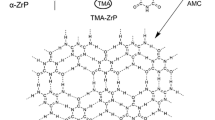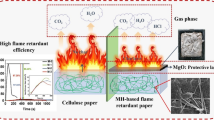Abstract
Recyclable flame retardant paper was made by constructing zinc coordinated multi-layered coatings consisting of positively charged polyethylenimine/melamine and negatively charged phytic acid. Herein, with the paper matrix as a carbon source, phytic acid was chosen as the acid source, while polyethylenimine and melamine served as the blowing agent. The successful deposition of zinc ion coordinated coating on the surface of paper fiber was confirmed by scanning electron microscopy and energy-dispersive X-ray. The weight gain of the paper (P) treated with 4 (P–4BL) and 8 (P–8BL) bilayers of coating were 5.5 and 10.1 wt%, respectively. After coordination with zinc ion, P–4BL–Zn and P–8BL–Zn were obtained with weight gains of 6.7 and 13.6 wt%, respectively. The thermal stability and flammability were evaluated by thermogravimetric analysis (TGA), horizontal burning and microscale combustion calorimeter (MCC) tests. TGA results demonstrated that the thermal stability of the treated sample was significantly enhanced at high temperature, as evidenced by the improvement of char residue at 700 °C for P–8BL–Zn to 31.6% as compared with that of untreated paper (1.6%). The P–8BL and P–8BL–Zn samples could achieve self-extinguishing in the horizontal burning test. MCC results showed that the peak heat release rate and the total heat release of P–8BL–Zn were reduced by 43 and 49% as compared to those of the untreated paper, respectively. Furthermore, the zinc ion coordinated coating displayed better in-water durability than the un-coordinated one, which made it possible recyclable flame retardant coating.
Graphical abstract








Similar content being viewed by others
References
Alongi J, Carletto RA, Di AB, Cuttica F, Carosio F, Bosco F, Malucelli G (2013) Intrinsic intumescent-like flame retardant properties of DNA-treated cotton fabrics. Carbohydr Polym 96:296–304
Alongi J, Blasio AD, Milnes J, Malucelli G, Bourbigot S, Kandola B, Camino G (2015) Thermal degradation of DNA, an all-in-one natural intumescent flame retardant. Polym Degrad Stab 113:110–118
Apaydin K, Laachachi A, Ball V, Jimenez M, Bourbigot S, Ruch D (2015) Layer-by-layer deposition of a TiO2-filled intumescent coating and its effect on the flame retardancy of polyamide and polyester fabrics. Colloids Surf A Physicochem Eng Aspects 469:1–10
Carosio F, Alongi J (2016) Ultra-fast layer-by-layer approach for depositing flame retardant coatings on flexible PU foams within seconds. ACS Appl Mater Interfaces 8:6315
Chang SC, Slopek RP, Condon B, Grunlan JC (2014) Surface coating for flame-retardant behavior of cotton fabric using a continuous layer-by-layer process. Ind Eng Chem Res 53:3805–3812
Chen S, Li X, Li Y, Sun J (2015) Intumescent flame-retardant and self-healing superhydrophobic coatings on cotton fabric. ACS Nano 9:4070–4076
Ejima H, Caruso F (2013) One-step assembly of coordination complexes for versatile film and particle engineering. Science 341:154
Fan W, Zhang Q, Wang Y (2013) Semiconductor-based nanocomposites for photocatalytic H2 production and CO2 conversion. Phys Chem Chem Phys 15:2632–2649
Fang F et al (2015) Intumescent flame retardant coatings on cotton fabric of chitosan and ammonium polyphosphate via layer-by-layer assembly. Surf Coat Technol 262:9–14
Fang F, Tong B, Du T, Zhang X, Meng Y, Liu X, Tian X (2016) Unique nanobrick wall nanocoating for flame-retardant cotton fabric via layer-by-layer assembly technique. Cellulose 23:3341–3354
Foyle T, Jennings L, Mulcahy P (2007) Compositional analysis of lignocellulosic materials: evaluation of methods used for sugar analysis of waste paper and straw. Biores Technol 98:3026–3036
Hauser PJ, Tabba AH (2001) Improving the environmental and economic aspects of cotton dyeing using a cationised cotton. Color Technol 117:282–288
Hong N, Pan Y, Zhan J, Wang BB, Zhou K, Song L, Hu Y (2013) Fabrication of graphene/Ni–Ce mixed oxide with excellent performance for reducing fire hazard of polypropylene. Rsc Adv 3:16440–16448
Hu W et al (2014) Flame retardant polystyrene copolymers: preparation, thermal properties, and fire toxicities. Polym Adv Technol 25:631–637
Imam SH, Cinelli P, Gordon SH, Chiellini E (2005) Characterization of biodegradable composite films prepared from blends of poly(vinyl alcohol), cornstarch, and lignocellulosic fiber. J Polym Environ 13:47–55
Khazma M, Goullieux A, Dheilly RM, Quéneudec M (2012) Coating of a lignocellulosic aggregate with pectin/polyethylenimin mixtures: effects on flax shive and cement-shive composite properties. Cem Concr Compos 34:223–230
Köklükaya O, Carosio F, Grunlan JC, Wagberg L (2015) Flame-retardant paper from wood fibers functionalized via layer-by-layer assembly. ACS Appl Mater Interfaces 7:23750–23759
Lam YL, Kan CW, Yuen CWM (2011) Effect of zinc oxide on flame retardant finishing of plasma pre-treated cotton fabric. Cellulose 18:151–165
Laufer G, Kirkland C, Cain AA, Grunlan JC (2012a) Clay-chitosan nanobrick walls: completely renewable gas barrier and flame-retardant nanocoatings. ACS Appl Mater Interfaces 4:1643
Laufer G, Kirkland C, Morgan AB, Grunlan JC (2012b) Intumescent multilayer nanocoating, made with renewable polyelectrolytes, for flame-retardant cotton. Biomacromol 13:2843–2848
Lecoeur E, Vroman I, Bourbigot S, Delobel R (2006) Optimization of monoguanidine dihydrogen phosphate and amino propylethoxysilane based flame retardant formulations for cotton. Polym Degrad Stab 91:1909–1914
Leistner M, Abu-Odeh AA, Rohmer SC, Grunlan JC (2015) Water-based chitosan/melamine polyphosphate multilayer nanocoating that extinguishes fire on polyester-cotton fabric. Carbohydr Polym 130:227–232
Li YC, Schulz J, Grunlan JC (2009) Polyelectrolyte/nanosilicate thin-film assemblies: influence of pH on growth, mechanical behavior, and flammability. ACS Appl Mater Interfaces 1:2338–2347
Li YC, Mannen S, Morgan AB, Chang S, Yang YH, Condon B, Grunlan JC (2011) Intumescent all-polymer multilayer nanocoating capable of extinguishing flame on fabric. Adv Mater 23:3926
Malucelli G, Carosio F, Alongi J, Fina A, Frache A, Camino G (2014) Materials engineering for surface-confined flame retardancy. Mater Sci Eng R Rep 84:1–20
Mao H, Wu X, Qian X, An X (2014) Conductivity and flame retardancy of polyaniline-deposited functional cellulosic paper doped with organic sulfonic acids. Cellulose 21:697–704
Mostashari SM, Zanjanchi MA, Baghi O (2005) Burning of a cotton fabric impregnated by synthetic zinc carbonate hydroxide as a flame retardant. Combust Explos Shock Waves 41:426–429
Navarro RR, Tatsumi K, Sumi K, Matsumura M (2001) Role of anions on heavy metal sorption of a cellulose modified with poly(glycidyl methacrylate) and polyethyleneimine. Water Res 35:2724–2730
Pan H, Song L, Ma L, Pan Y, Liew KM, Hu Y (2014) Layer-by-layer assembled thin films based on fully biobased polysaccharides: chitosan and phosphorylated cellulose for flame-retardant cotton fabric. Cellulose 21:2995–3006
Pan Y, Zhan J, Pan H, Wang W, Tang G, Song L, Hu Y (2016) Effect of fully biobased coatings constructed via layer-by-layer assembly of Chitosan and Lignosulfonate on the thermal, flame retardant, and mechanical properties of flexible polyurethane foam. ACS Sustain Chem Eng 4:1431–1438
Pan Y, Wang W, Liu L, Ge H, Song L, Hu Y (2017) Influences of metal ions crosslinked alginate based coatings on thermal stability and fire resistance of cotton fabrics. Carbohydr Polym 170:133–139
Qiu X, Li Z, Zhang Z (2018) Flame retardant coatings prepared by layer by layer assembly: a review. Chem Eng J 334:108–122
Wiles AB, Bozzuto D, Cahill CL, Pike RD (2006) Copper (I) and (II) complexes of melamine. Polyhedron 25:776–782
Wu N, Ding C, Yang R (2010) Effects of zinc and nickel salts in intumescent flame-retardant polypropylene. Polym Degrad Stab 95:2589–2595
Yuan B, Sun Y, Chen X, Shi Y, Dai H, He S (2018) Poorly-/well-dispersed graphene: Abnormal influence on flammability and fire behavior of intumescent flame retardant. Compos Part A Appl Sci Manuf 109:345–354
Zhang T, Yan H, Shen L, Fang Z, Zhang X, Wang J, Zhang B (2014) Chitosan/phytic acid polyelectrolyte complex: a green and renewable intumescent flame retardant system for ethylene-vinyl acetate copolymer. Ind Eng Chem Res 53:19199–19207
Acknowledgments
The authors wish to thank the support from the National Natural Science Foundation of China (#51573173), Research Foundation from Hangzhou Dianzi University (KYS205618028) and Innovative R&D Research Fund of Hangzhou Dianzi University (ZX140206318006).
Author information
Authors and Affiliations
Corresponding author
Electronic supplementary material
Below is the link to the electronic supplementary material.
Rights and permissions
About this article
Cite this article
Pan, Y., Liu, L. & Zhao, H. Recyclable flame retardant paper made from layer-by-layer assembly of zinc coordinated multi-layered coatings. Cellulose 25, 5309–5321 (2018). https://doi.org/10.1007/s10570-018-1922-0
Received:
Accepted:
Published:
Issue Date:
DOI: https://doi.org/10.1007/s10570-018-1922-0




